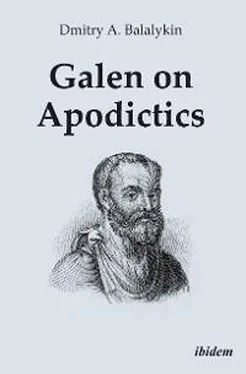We will try to illustrate the foregoing with a specific example—the term “apoplexy” used by Galen. In literature, this concept is often associated with the modern-day nosological entity of “stroke”. Such an interpretation has the right to exist, it is certainly logical from a clinical point of view. 11However, broadly speaking, Galen’s “apoplexy” should not be considered exactly the same as the modern term “stroke”. 12
What did Galen mean by the term “a fit of apoplexy”? In one of his works, he defined apoplexy as a state when there is simultaneous loss of sensation and motor functions. The definitions and descriptions of this disease may differ in his various works, but this difference can be reduced to a common denominator. Apoplexy is characterised by the following symptoms: abrupt manifestation of disease, comatose state, violation of motor functions of the entire body, simultaneous loss of sensation, shallow breath, weak, slow pulse, violation of speech function, chronic disease progression. This often has a fatal outcome. The addition of fever to the above-described symptoms may have led to the condition Galen referred to as “lethargos”, i.e., loss of mobility and sensation of a certain side of the body. The concept which corresponds to its description in today’s medical vocabulary is “paralysis”. On the other hand, Galen’s understanding of the term “apoplexia” (“fit of apoplexy”) was broader than today’s. The modern-day doctor may associate a case of sudden, simultaneous, complete loss of mobility and sensation, including with impairment of consciousness and breathlessness with the manifestation of several diseases, starting with brain trauma, heart attack or pulmonary embolism with loss of consciousness and ending with acute toxic response. The equation of the meaning of a fit of apoplexy in Galen’s work with the modern-day concept of stroke, which, at first sight, seems obvious, may lead the medical historian to the wrong interpretation of the text of the source.
For ancient doctors, the correct prediction of the course and outcome of a disease was more important than terminological nuances of diagnosis. Hence, depending on the severity of the disease, Galen drew a distinction between two forms of apoplexy, which are judged based on the familiar symptoms of irregular breathing and pulse. Critical deviations from the natural respiratory rhythm and the corresponding changes in pulse pointed to an incurable form of apoplexy with high likelihood of a fatal outcome. Minor violations of vital functions enabled to make an optimistic prognosis of the course of the disease. However, already at the stage of this distinction, the difference between the views of Galen and the views of the modern doctor with pathogenetic thinking is noticeable. Galen considered breathlessness as only the result of the patient’s failure to move chest muscles. In other words, his ideas are also associated with anatomical-physiological factors, but exist in a different “explanatory model” from today’s—investigative capabilities determine the type of rationality of the scientist.
In order to understand Galen’s views, how he explained the origin of the fit of apoplexy is crucial. To this end, a concrete clinical problem in Galen’s system of general pathology—the theories of the movement of blood and the balance of the four humors—has to be examined. According to the Platonic tradition, of which Galen was an advocate, blood is continuously synthesised from assimilated food. Part of the food, which is useful for this purpose, is absorbed from the stomach and carried through the portal vein to the liver. There, it is converted to venous blood and “vegetative spirit” (pneum, generated by lower part of the soul), which supports the functions of growth and nourishment, and spreads to all parts of the body through veins. Inspired air becomes “vital spirit” (pneum, generated by middle part of the soul) upon entering the left half of the heart. The heart and arteries are responsible for maintaining and distributing natural heat (this was one of the key principles of the medical theory of Aristotle, as interpreted by Galen). This concept explained the fundamental principles of the functioning of the body. Galen believed that, while passing through the arteries, both the blood and the “vital pneuma” warmed up parts of the body, nourished them and maintained their vital function. The transformation of “vital spirit” occurred in the arteries, which formed the so-called “rete mirabile”—a network of vessels which, according to Galen, was located at the base of the brain. It is specifically in the rete mirabile that “vital spirit” turned into the “animal spirit” (pneum, generated by higher part of the soul), which Galen believed was located in brain ventricles (the fourth ventricle played the main role in his theory) and was the mediator for the transmission of motor and sensory pulses to all parts of the body. The transmission process occurred through the flow of the “animal spirit” via nerves, which Galen thought of as hollow tubes. The “animal spirit” reached specific body parts, passing them arbitrary “commands” from the higher, “rational” part of the soul located in the brain. This way, Galen attempted to establish the principles of interaction between the blood circulatory system and the nervous system. His model was based on Plato’s tripartite theory of soul, the concept of the three kinds of pneuma 13and the idea that the brain is the centre of control of the arbitrary functions of the body.
Galen’s theory was also based on the Hippocratic theory of the four liquids—blood, phlegm, black bile and yellow bile,—and their associated qualities—hot, cold, moist and dry. Overabundance of one of the humors could be the reason for the violation of their good mixture (or “dyscrasia”), leading to the dysfunction of the body in the form of any given disease. Galen considered two scenarios of the development of apoplexy. In one case, he suggested the possible development of apoplexy in the form of local “dyscrasia”; the accumulation of a dense, viscous and sticky fluid in brain ventricles blocked the movement of the “animal spirit”, which in turn made difficult or stopped the transmission of sensory and motor pulses between the brain and other parts of the body. In the other case, which best matched the modern concept of hemorrhagic stroke, apoplexy developed as a result of local plethora. Brain tissue is overfilled with excess blood, which squeezes it. The result of this excess pressure is the impairment of the functions of the brain as the centre of control of body parts. In this case, Galen does not explicitly claim that the plethora of the brain is the result of haemorrhage. Ultimately, at the last stage, both scenarios of the development of the disease lead to a critical change in the temperature of the brain and subsequent cessation of the circulation of the “animal spirit”.
Galen’s interpretation of the causes of brain injury as the pathological change in the movement of the “animal spirit” enabled to consider disease as a result of anatomical and functional violation of the unity of the spiritual and the corporeal. Furthermore, such a view took into consideration the possible pathogenetic effect of body ageing processes and external factors on the likelihood of the development of apoplexy. During clinical observations, Galen paid attention to the fact that the average body temperature in the elderly was usually lower than in younger people. It followed that their bodies were more susceptible to the so-called cold diseases, for example, caused by excess yellow bile. Also of great significance were climatic and seasonal factors, which influenced the “good mixture” of liquids (for example, sparking an increase in the accumulation of yellow and/or black bile in the body). Overcooling of the brain with subsequent development of bouts of disease could be a result of an unhealthy lifestyle. Any excessive eating was considered harmful: in particular, excessive consumption of wine, according to Galen, reduced natural body heat and was undesirable. The plurality of external factors, such as climate and season, and internal predispositions (age, bad habits, etc) led to the cooling of the body and was the cause of “cold” diseases.
Читать дальше












